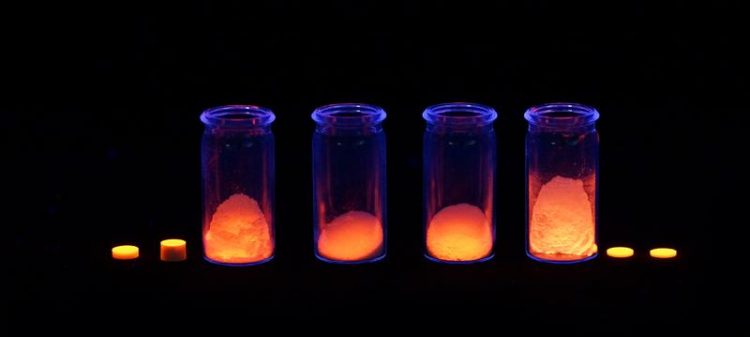New transparent luminous pigments provide high temperature stable protection against counterfeiting

New transparent luminous pigments provide high temperature stable protection against counterfeiting. Copyright: INM
Everyone knows the small UV lamps at cash desks in supermarkets. They are used to verify whether “big banknotes” are genuine. To do so, colorful snippets light up inside the note. The luminous particles which cause this consist of organic compounds.
They are not suitable for high temperatures because, in such cases, the luminous particles disintegrate. They therefore cannot be used to provide counterfeiting protection for objects that are subjected to high temperatures.
Now research scientists at INM – Leibniz-Institute for New Materials have developed luminous particles that can also withstand high temperatures. When activated by UV light or x-rays, they glow orange red.
The researchers will be presenting their results from 25 to 29 April 2016 in Hall 2 at the stand B46 of the Hannover Messe in the context of the leading trade fair for R & D and Technology Transfer.
Engine components in cars, high-grade machinery for the industrial sector or high-value appliances in private households – some of these everyday objects are subjected to high temperatures when used. Original automotive components and the corresponding spare parts are a seal of quality for manufacturers and consumers:
For the driver, original components mean that the risk of accident is lower. Originality of the parts can only be proven, if the counterfeit protection also withstands high temperatures and can be read easily. A missing counterfeit protection on forged spare parts guards the original manufacturer from claims for compensation.
“For our luminous pigments, we can achieve such temperature stability up to 600 degrees Celsius,” says INM’s Peter William de Oliveira. The developers at INM have succeeded in doing so by using a manufacturing method applying wet chemical processes.
“The particles not only fulfill the demands of high temperatures but through the addition of suitable solvents, they can also be converted into printable paste. Consequently, they can easily be printed onto many materials using screen printing, for example,” the Head of the InnovationCenter at INM explains further.
Using luminous pigments made of yttrium oxide or gadolinium oxide, printed designs are created in white or transparent that glow orange red in UV light or x-rays. With different manufacturing conditions, particles of between seven and approximately 600 nanometers can be achieved thus alloying the researchers to take different requirements and processes in industry into account.
Your contact at the stand:
Dr. Michael Opsölder
Jana Staudt
Your expert at INM:
Dr. Peter William de Oliveira
INM – Leibniz Institute for New Materials
Head Optical Materials
Head InnovationCenter INM
Phone: +49681-9300-148
OptiMat@leibniz-inm.de
INM conducts research and development to create new materials – for today, tomorrow and beyond. Chemists, physicists, biologists, materials scientists and engineers team up to focus on these essential questions: Which material properties are new, how can they be investigated and how can they be tailored for industrial applications in the future? Four research thrusts determine the current developments at INM: New materials for energy application, new concepts for medical surfaces, new surface materials for tribological systems and nano safety and nano bio. Research at INM is performed in three fields: Nanocomposite Technology, Interface Materials, and Bio Interfaces.
INM – Leibniz Institute for New Materials, situated in Saarbrücken, is an internationally leading center for materials research. It is an institute of the Leibniz Association and has about 220 employees.
Media Contact
All latest news from the category: Materials Sciences
Materials management deals with the research, development, manufacturing and processing of raw and industrial materials. Key aspects here are biological and medical issues, which play an increasingly important role in this field.
innovations-report offers in-depth articles related to the development and application of materials and the structure and properties of new materials.
Newest articles

A ‘language’ for ML models to predict nanopore properties
A large number of 2D materials like graphene can have nanopores – small holes formed by missing atoms through which foreign substances can pass. The properties of these nanopores dictate many…

Clinically validated, wearable ultrasound patch
… for continuous blood pressure monitoring. A team of researchers at the University of California San Diego has developed a new and improved wearable ultrasound patch for continuous and noninvasive…

A new puzzle piece for string theory research
Dr. Ksenia Fedosova from the Cluster of Excellence Mathematics Münster, along with an international research team, has proven a conjecture in string theory that physicists had proposed regarding certain equations….



